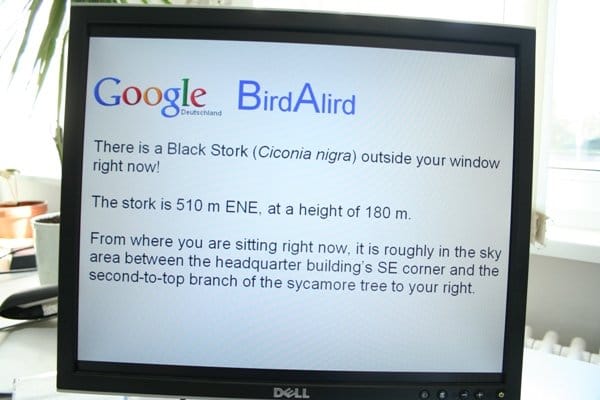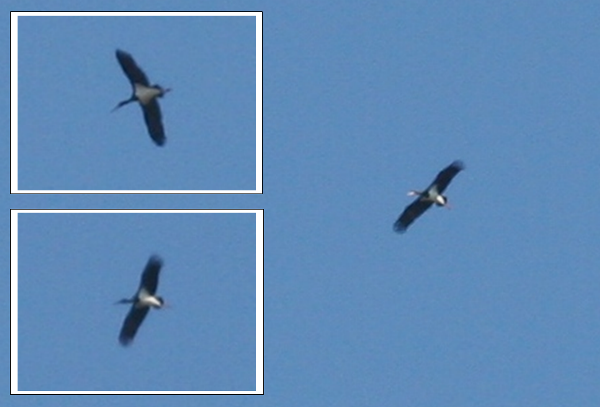This is a short account of what happened one fine Monday around noon, March 21st of 2011, while I was at work. It won’t need many accompanying words, so I won’t deliver many. Suffice to say at the onset that it was a beautiful and blue Monday morning, as beautiful and full of migratory vibes as Mondays in spring can get after a miserable and cold, rainy, cloudy, shabby, busy & birdless weekend.
As it won’t need many words (I have mentioned this, yes?), I’ll present it as a short picture story.
There I was at my office on Monday, fully motivated after the weekend and hard at work. Birds & birding were definitely the last thing on my mind.
Suddenly my BirdAlird went off, disrupting my sleep deep thoughts and sending a mouthful of coffee over my desk – a Black Stork?!?
I immediately realized the blog potential of this, grabbed my camera and opened the window, following the precise directions of my BirdAlird, and by the Great Ghost of Audubon …
A splendid Black Stork!
The Black Stork (Ciconia nigra) has a very wide distribution in the Old World, ranging from Spain (an isolated population) and northern France through central and eastern Europe all across northern and central Asia to the Pacific coast of Russia and China. They mostly winter in Africa just south of the Sahara and in southern Asia (from India to southern China), and there is – very curiously – an isolated resident population in southern Africa. Due to its large range and population size, it is rated by the IUCN as being a species of Least Concern.
Germany currently has a population of around 500 breeding pairs, which is a significant improvement over the 50 pairs left in the early 1970s. However, if you consider that these 500 pairs are spread out unevenly over an area of 360,000 km², and that Black Storks are very difficult to see once they start breeding, it is apparent that a Black Stork is still a very nice bird to see in Germany – anytime, anywhere.
This bird, a migrant from further North or East in Germany, was the first Black Stork I saw around Heidelberg since moving here in the summer of 2008. It was therefore well worth having to clean my desk of the coffee I spilled.















This is the coolest BirdAlird story I have ever heard, amazing!
Hee hee..I need one of the Google BirdAlirds…That would be a wonderful invention!
BirdAlird is near completion and just needs a small final investment to get it into production. Send Jochen a check and he will make sure to get it done!
Is that a green mouse on a skateboard on your mug? Surely you have a mug with a bird or two on it??!!
Oh dear….a cyclist living dangerously without a helmet on!
Nice post!
Very nice stork. Very goth.
Man, what a bird to see from the office! Let us know when you got that BirdAlird application up and running.
http://elephantseyegarden.blogspot.com/2010/09/photographing-birds-in-our-garden.html
Yes, we had a black stork, land in our garden here in South Africa ;~)
@YourBirdOasis: thanks!! Yes, sometimes BirdAlird works very well.
@Dawn: so I can count on you as a subscriber to this future online application? 🙂
@Corey/all: yes, yes, yes! Please, send checks. Never mind filling out the numbers, I’ll do that for you. Just send them blank! 😉
@Clare: no, it is actually a green concrete lorry. I work as a biodiversity manager for the building industry. Can you believe it?!
Cyclists here don’t live all that dangerously as Germany has a very dense network of specific bicycle lanes. Those who live dangerously are young birding fathers who use those bicycle lanes for going for a walk with their toddler in a stroller.
@Carrie: Ha! You are absolutely right. Everything from their behaviour and habitat choice to the fine red eye make-up and lipstick is Goth art at its finest. I’ll now chant “Lullaby” whenever I see a Black Stork.
@Pat: yes, it was very neat. However, this was the only good bird I saw from my office in almost three years – and that’s a bit sad actually.
I’ll have BirdAlird up and running as soon as I have caught each and every bird on this planet and fitted a satellite transmitter to it – see reply to Corey’s comment! I’ll let you know.
@Elephant’s Eye: that is amazing! I was very fortunate to travel widely throughout south-western Africa (Cape Province and Namibia) and saw quite a few Black Storks there. It is mind-blowing how different their habitat choices are compared to Europe where they live in absolutely large, dark and deep forests along quiet wooded streams and ponds. And then you spot them sitting on telephone poles next to water windmills in the open Karroo. Unbelievable!
Thanks for the link, very much appreciated!